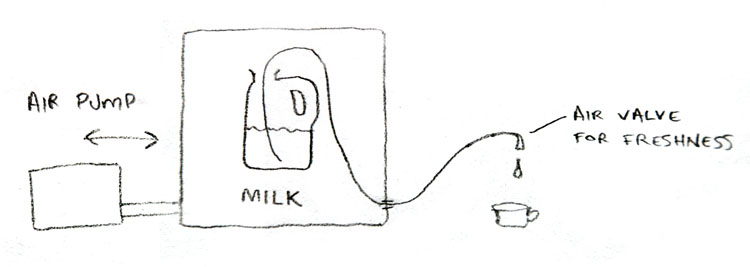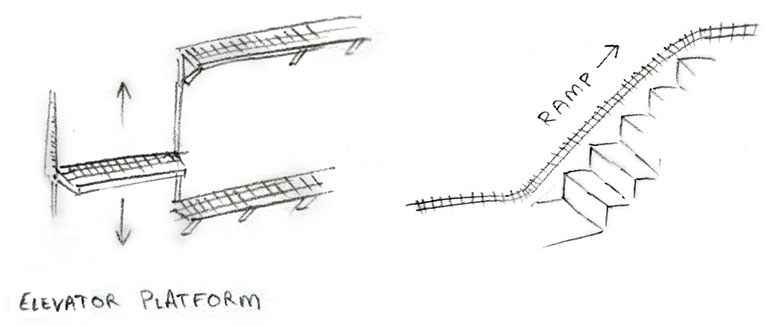
The Mountain Railway Morning Brew
5 Jul 2008Progress: Design Stages
I've had this idea for years. It combines two great and difficult projects into one.
In short, you press a button in your bedroom, and downstairs in the kitchen station a fresh cup of tea is made. It is loaded onto the back of a model train, and is then delivered to you by model traintrack. It's extravagant, but awesome.

Let's split it into two parts.
The tea making machine
This isn't some crappy instant tea machine or thing you have to set the night before. This needs to make perfect tea, and not need any of its supplies refilling by hand each time. It should be able to make around forty cups before you need to restock it.
The glorious part of it is that you're no longer restricted to having it in a certain location. And since it's quality we're after, there'll be no more sachets of long life milk - this has to be perfect.
There are a lot of issues with a project like this. It needs to boil water, and for that it needs a water supply, it needs to handle tea bags or leaves, and it needs to handle adding milk and sugar. Milk is, of course, a problem, and usually the main problem with tea making machines. However, on this machine, the station can be situated right next to the fridge. We're limited by the amount of piping and hardware that touches the milk, because each time the milk is replaced, all the pipes need to be sterilised. Pumps are out of the question. Any part of the machine outside the fridge can't have milk remain in it while the machine is idle. It also needs to be easy to refil, with no customised containers or anything. And cheap, of course. My solution?

Have an air pump connected to the fridge. The only part that gets touched by the milk is the single tube, which can be taken out and washed. To prepare, simply place the milk in the fridge, open the top and put the pipe in, to the bottom. Close the door to make it air tight. When milk is needed, air is pumped into the fridge, and the pressure forces milk to leave through the tube. After, air is drawn out to create a negative pressure, and so excess milk in the pipe is drawn back into the bottle. A simple valve at one end would stop air getting in when not in use, but shouldn't actually get touched by the milk.
As for the tea bag dispenser, the easiest might be to have a row of slots for tea bags that you manually insert them into. There would be no support for tea leaves, but I can't think of a solution that would accept both. Maybe two seperate dispensers would be best.
Sugar shouldn't be a problem as it isn't going to go rancid or anything. It's important to ensure there aren't any leaks though.
The delivery train
Again, there are many challenges to overcome. The train will probably have to be G gauge or a similar scale. The drink could be carried on one of its carriages in several ways - the simplest being a flat carriage, with a mug holder, the most impressive being one styled like an oil tanker, which is actually a thermos flask on its side. This would be difficult to clean though.
Undoubtedly the biggest problem with having one station downstairs and one station upstairs is getting the train between the two. Depending on how permenant an insallation the system would need to be, archways and bridges could be used to get the traintrack to the staircase, but what then? The two most obvious ideas are: have sloping track, or have the train stop on a detaching piece of track, which itself is an elevator between levels.

Sloping track means some kind of grip would be needed - or a chain pull to support it, like on roller coasters. However, all the carriages and their contents would be tipped at a pretty steep angle, so they'd need to be very secure, and any mugs of tea would need to have covers on them. Fine if it was being loaded by hand, but for an automated machine this would be very difficult.
An elevator keeps the train level, but limits the number of carriages significantly. It would also be fairly complicated to construct, at least in comparison to the slope. Even more so if the platform was only big enough for one carriage, and they had to be loaded separately. Still, with a microcontroller and plenty of sensors, it's not out of the question. I guess this part mostly depends on budget. I think the elevator is the best idea though, as the carriages could be much simpler, and the whole system would look so much cooler.